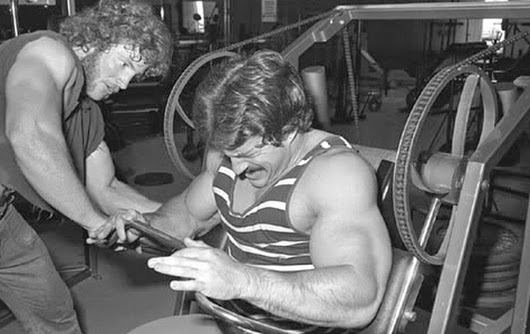One of the main differences and points of contention in weight lifting is frequency and duration of workouts. We’ll see in this article how brief workouts produce significant strength gains.
How often should you train for strength?
Bodybuilders, gyms, and most publications devoted to it advocate that you train often, as frequently as five times a week. Is this necessary, and is this optimal?
The fitness industry has an obvious conflict of interest here: it wants you to use their products as much as possible in order for them to earn more money. If you are told to workout more often, you will be more likely to renew your gym membership, buy more supplements and equipment and magazines, and just generally to order your life so it revolves around weight lifting and fitness.
Others, more scientifically oriented, claim that you don’t need to train as often to maximize muscle gains, nor that you need to do more than one set of each exercise. In the very informative book Body by Science, Doug McGuff, M.D. advocates brief, once weekly workouts, a far cry from the three to five a week often advocated elsewhere. McGuff bases his recommendation on a number of things, most importantly the speed at which muscle recovers and grows from an intense workout, which is much slower than most people think.
I previously touched on the issue of workout frequency in my article on high-intensity training.
A real-world test of brief, infrequent workouts
Another aspect of infrequent workouts is that most people — normal people — are uninterested in spending hours a week in the gym. Indeed, getting normal people to exercise at all, much less lift weights, is a challenge.
Older people especially need strength training, since they lose muscle with age. Getting these people into the gym can greatly improve their health.
If older and or normal people — and by “normal” I mean those not interested in bodybuilding, because face it, we bodybuilders are a little weird — can gain strength and obtain health benefits with minimal gym time, that would be a breakthrough.
So a study was undertaken to see whether they could: “Strength Gains as a Result of Brief, Infrequent Resistance Exercise in Older Adults”.1 The lead author is James Fisher, a British exercise scientist who’s done lots of interesting work.
In the study, 14 men and 19 women, average age 55, worked out for 12 weeks.
The sessions were very brief at less than 15 minutes each, and they were infrequent, at twice a week.
The participants did a routine essentially the same as advocated in Body by Science, consisting of
- pull down
- chest press
- seated row
- overhead press
- leg press
In addition:
- All work was done on machines, another plus for getting real people to do resistance training.
- Each exercise was done at one set to failure.
- Each exercise was done using super slow rep cadence: 10 seconds up, 10 seconds down.
- As strength was gained during the study, weight was added to each exercise. This is the principle of progression.
- And each participant was encouraged to move to the next exercise quickly, generally in less than 30 seconds.
This is almost exactly like the Body by Science program, with the exception that the book recommends once weekly training, and in the study, training was twice weekly. (Some nuance: Body by Science recommends that trained people workout once weekly, and the study used untrained people.)
Results, in terms of strength gains relative to body mass, shown below.

For a total time commitment of 30 minutes a week, these older adults showed large and significant strength gains, as much as 55% more than when they started. Undoubtedly if they continued the program longer they would continue to gain in strength.
Among other things, this study showed that intensity of effort is very important for gains.
The authors comment:
The data herein represents “real people, doing real resistance exercise” from which they are intending to acquire the aforementioned health and fitness benefits…
Previous research suggests that perceived difficulty and misinformation about expected outcomes are barriers to older persons performing resistance exercise. This study presents data from a UK based exercise facility where sessions are performed on a 1 : 1 basis (client : trainer). The study shows that resistance training need not be time consuming, dauntingly complex, or overly difficult, and that considerable increases in strength can be achieved. [My emphasis.]
While this study showed that these gains were possible and highly practical, it doesn’t show what’s optimal for the greatest gains, which is what dedicated bodybuilders are normally interested in. However, due to the number of variables in strength training, demonstrating the optimal workout routine is a difficult proposition.
Conclusion
This study shows that brief, infrequent workouts produce significant and substantial gains in strength in older adults.
Highly frequent and long workouts are not necessary, and telling people that they are may result in many fewer people taking up strength training.
Whether this type of workout routine maximizes strength gains is another story.
In upcoming articles, I will explore some of the science behind strength training to see if we can discover what really works in weight lifting, what doesn’t, and what’s superfluous.
- Fisher, James, et al. “Strength gains as a result of brief, infrequent resistance exercise in older adults.” Journal of sports medicine 2014 (2014). ↩














15 Comments
I’m pretty sure that the chap in the photo accompanying this article doesn’t just do brief, infrequent workouts 😉
Hi P.D., do you agree with what Baron is saying?
That the guy in the photo doesn’t do brief, infrequent workouts? Yes, I agree with him that he doesn’t, but it requires a more complicated answer. To get really big and really ripped, all-star genetics aside, requires drugs. If someone uses those drugs, they can work out much more often with better recovery, and this may have a lot to do with how steroids work. Not sure if the man in the photo is quite that big, looks like it though.
The main question, as I mentioned in the post, is what is optimal for maximum muscle gains, and that’s a difficult question to answer. Will the Body by Science program, done 2 x week, turn you into a bodybuilder? Seems unlikely. But, if it doesn’t, and intensity is the key to building muscle, as I believe it is, and muscles require up to a week of rest between high-intensity workouts, then how do you design a program to become a bodybuilder, without drugs? I don’t know the answer.
Recovery time can be reduced through nutrition. Diet is a major factor in recovery time after rest. The documentary Powered By Green Smoothies had results reflecting this. Athletes increased their performance/recovery noticeably via a single change; drinking a green smoothie each day.
For a Noobe trying to build body tone does it make more sense to do a ladder method i.e. 10 reps at 60, 70, 80, 70, 60? Assuming top point is max 10 rep weight
One set to failure is all you need, newbie or not.
This is a great topic and one that I can never seem to get a handle upon. Perhaps I’m that hard gainer type, which is on the regrettable side but if my strength arrives along with the benefit of flexibility, which I might not have the luxury of if I was “stacked” instead of simply, “jacked,” I’m fine with the lack of huge gains.
Naturally the infrequent but intense training regimen is attractive to me as well as most people who wouldn’t ordinarily pursue consistent resistance training but I wonder if that study went on for another 12 weeks or more, what their gains might look like.
Due to suffering from some illness, which I had to forgo training, I noticed that I was getting bigger by only working out once or twice per week. Who knows if there’s anything in this, but gonna keep my eye on this type of training!
3 times per week to me is enough.
But how much of this “strength gain” was muscle mass gain vs only nervous system adaptation?
Is exercise to failure recommended for a person beginning weight lifting at 80 years old?
Good question. Of course, someone that age needs to be medically cleared for exercise. Doug McGuff, who wrote the book Body by Science, which advocates high-intensity training, seems to think even very old people can train to failure. I would say a beginner at that age should get some training under his belt first.